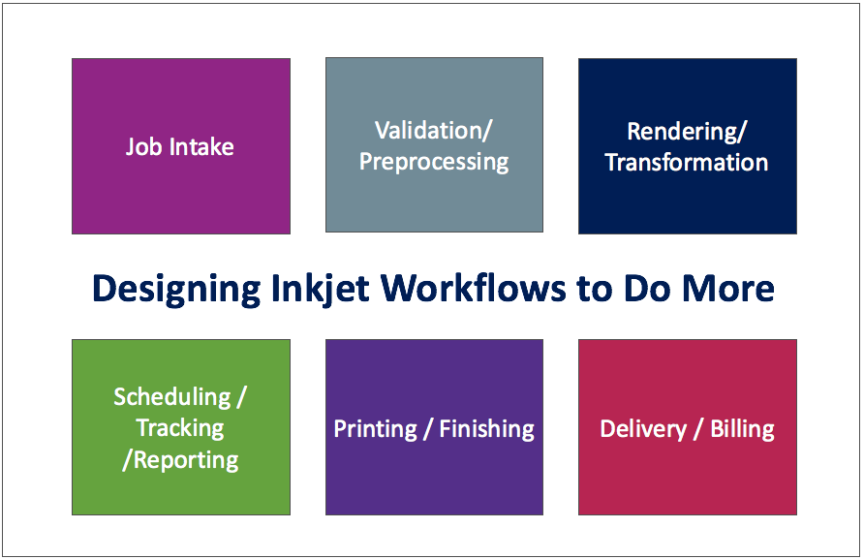You may hear about book workflow, graphic arts workflow, direct mail workflow or maybe transaction printing workflow as unique solutions. While every workflow should be unique to the service provider, thinking of the workflow solution as unique to a particular application segment can limit a company in terms of their workflow design and potential for page growth on their inkjet device(s).
In every segment, general areas of tasks and processes have to be managed and ideally, automated. The general areas are fairly similar across business segments, for example:
- Job/file intake
- File validation/preprocessing
- Image rendering/transformation
- File post processing
- Production scheduling, tracking, reporting
- Printing (and electronic production)
- Finishing
- Delivery
- Billing
However, the specifics within those general buckets, and the flow of work between buckets, can be very different. Traditional thinking is that If the jobs and flow are different, then the approach to automating their workflow must be different as well. I disagree, the PROCESS for designing the workflow is the same:
- Document all current work processes from the ability to receive (or internally create) a job through the delivery of the finished product to client billing.
- Identify all discrete aspects of the work that can be automated
- Define the most streamlined process for each unit of work
- Design flows that put those “automated units of work” together in different ways for different jobs
It’s the resulting workflow design that is unique. However, when you think about workflow design in this basic way, you may realize that breaking work down into smaller units (sort of like the concepts of object oriented programming) gives you the flexibility to put workflows together in different ways for different jobs using the same component parts:
In a transaction print or direct mail environment, workflow design may be focused on data validation, variable composition, load balancing and postal processing. Transaction printers should also plan to take in large graphics files for clients who want to add messaging or educational materials to their statements. I’ve had clients that wanted to send their statements as a booklet. That requires an imposition step not typically associated with transaction printing.
In a graphic arts environment, workflow design may be more focused on authoring or ordering aspects of the process and but that doesn’t mean commercial printers shouldn’t be looking closely at options for data validation and thinking about options for handling more data-driven jobs.
Modern book printers have very complex workflows that enable different publications to be sent to the printer as a single job and processed through the remainder of the workflow as “jobs of one.” These jobs of one effectively put book printers in the mailing business and cause more overlap with transaction printing and direct mail than one might initially expect.
Designing reusable components within your workflow, and “stubbing in” steps for other types of work you may do in the future, will make your workflow system more flexible, extensible and auditable.
Data is changing the nature of most application segments today. Inkjet is enabling books, collateral, direct mail and even signage to be data-driven in a cost effective way. Data and inkjet together are blurring the boundaries between application segments and the companies that operate in those segments. Many companies now want to do more than one thing with their equipment. You won’t magically gain capabilities to jump into new sectors by adding modules in your workflow, but hard-coding workflow to align to the current vision of a particular application segment will almost guarantee that you can’t. Plan to do more and keep the door open to opportunity.
For some of the other areas to consider when evaluating opportunities to grow your inkjet pages by moving into new market segments, listen to the recent webinar by Mary Schilling “Six Sensible Steps Towards Doing More with Inkjet.”

